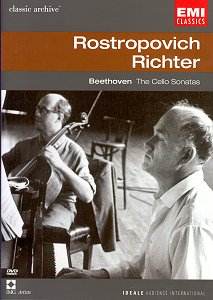Take two of the twentieth century’s greatest instrumental
soloists, put them together at the service of Beethoven in a live recital,
film it and you get what we have here – an historic musical document
that is both important and inspirational.
This single concert was recorded at the Usher Hall
during the Edinburgh Festival in 1964 and the West was still getting
used to being able see and hear these sensational Soviet artists in
the flesh. Until the late ’fifties they had been virtually locked behind
the "Iron Curtain".
It was an uncompromising recital, starting for some
reason at midnight and consisting entirely of the complete cello sonatas
of Beethoven. Those prepared to stay up late for the event probably
thought, "This is going to be something I can tell my grand-children
about". The audience show their appreciation with prolonged applause
before a note is played. This contributes to a little comedy of errors.
The two mount the platform, Rostropovich carrying his cello, Richter
an extremely dog-eared and heavily sellotaped volume of the sonatas
which he then puts on the piano upside down while the page turning man
starts to fiddle with something at the side of the piano. They sit.
Because the applause will not stop they stand for another bow, getting
tangled with the turning man who is trying to get to his chair. They
sit again. Silence. Then Richter finds his stool at quite the wrong
height so gets up and stands behind it to give the knobs a prolonged
twiddle. Then they start to play and at once we know we are witnessing
something special. A sudden, intense musical concentration takes over
as we are subjected to the beautifully sculptured melodic lines of Rostropovich’s
cello in the opening adagio of the F major sonata followed by the piano’s
announcement of the first subject of the allegro played with that unmatchable
Richterian combination of zip and delicacy.
The recital organised the sonatas in chronological
order which, incidentally, provides us with a sweep from early Beethoven
via middle period to the threshold of late period. The first two sonatas
broke new ground in that they are a genuine dialogue between the two
instruments, the piano elevated from accompanying bit part to virtuoso
partner with the cello. This was new. The last sonata of the evening
(or morning!) matures into what some think the finest of all cello sonatas
culminating in a fugato that sends a message that we are approaching
Beethoven’s so-called third period.
The performances are filmed, as was the way in those
days, with very few camera angles and no fussy panning and zooming to
distract. This helps the viewer to share some of the concentration so
evident on the stage. Here are two artists very much at one although
they cannot see each other – Rostropovich facing the audience, Richter
behind him facing away and sideways. But they play bound with a sure
interdependence, as if attached by some invisible umbilical chord. Occasionally,
at key points, Rostropovich will lean and half glance sideways, and
Richter never looks to his partner, being glued to the music at all
times. I do not know how many times they had played these sonatas before,
although they had recorded them for Philips over the previous three
years. The evidence is that these are highly honed performances, great
ones in which the pair had arrived at a perfect mutual understanding
of each other. There may be interpretative issues that are not to everyone’s
taste, for example there is an occasional approach to tempi that might
sometimes be associated with Richter, that of taking some fast movements
faster than the norm, and some slower ones, slower. But then there are
so many instances of passing moments that one cannot imagine any other
duo matching, for example the profound, quiet stillness of the start
of the great adagio in the final sonata.
As the recital comes to its end after the rigours of
the fugato ending of that last sonata, the players immediately rise
and in what looks to be an expression of joy, satisfaction and mutual
admiration, Rostropovich kisses Richter on the cheek and they bow holding
hands. A lovely little moment in the context of a great recital, all
caught on film that is a privilege to watch.
The DVD’s "bonus" item, Richter playing Mendelssohn’s
Variations sérieuses, was recorded in Moscow two years
later. The film quality is poor and the sound dire, but it is a welcome
curiosity – Richter never recorded the work commercially. It is a piece
that well shows off Richter’s unique brand of virtuosity, power and
delicacy.
John Leeman

![]() Mstislav Rostropovich,
cello
Mstislav Rostropovich,
cello![]() EMI CLASSICS DVB 4928489
EMI CLASSICS DVB 4928489
![]() [128:37]
[128:37]